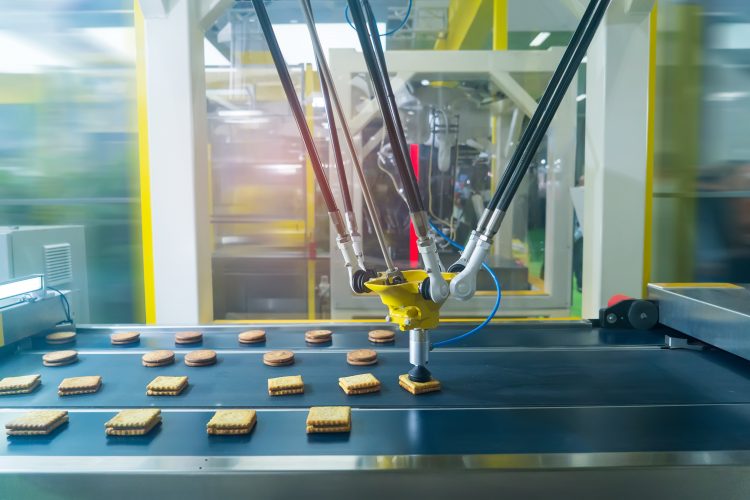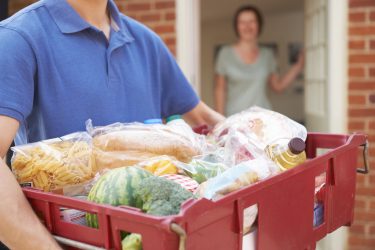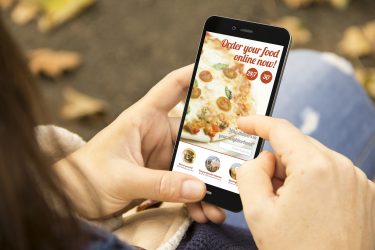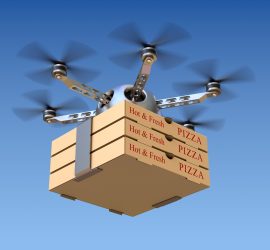How will the food and drink industry embrace technology?
- Like
- Digg
- Del
- Tumblr
- VKontakte
- Buffer
- Love This
- Odnoklassniki
- Meneame
- Blogger
- Amazon
- Yahoo Mail
- Gmail
- AOL
- Newsvine
- HackerNews
- Evernote
- MySpace
- Mail.ru
- Viadeo
- Line
- Comments
- Yummly
- SMS
- Viber
- Telegram
- Subscribe
- Skype
- Facebook Messenger
- Kakao
- LiveJournal
- Yammer
- Edgar
- Fintel
- Mix
- Instapaper
- Copy Link
Posted: 30 June 2020 | Bethan Grylls (New Food) | No comments yet
Covid-19 has accelerated the deployment of technology in the global food and drink supply chain. Here, tech expert, Paul Cuatrecasas explains how…


Lockdown has thrown society a few curveballs in the last few months, but despite all the challenges and negatives it has hurled our way, there is no doubt that it has also brought opportunity.
The COVID-19 pandemic has been a propeller for change, driving the food and beverage sector to think innovatively about the ways it can tackle restrictions and new obstacles. As a result, the interest and implementation of digital solutions have accelerated rapidly.
“Our entire food ecosystem is being disrupted,” said Paul Cuatrecasas CEO of investment banking firm Aquaa Partners and author of ‘Go Tech or Go Extinct’.
Embracing technology
Online US grocery revenue reached $20 billion last year, and sales are forecasted to grow by 18 percent year-on-year, according to eMarketer.
Food companies are having to innovate to keep pace with this technological shift and fight off increasing competition from other sectors. From virtual reality (VR) headsets that let the customer shop from their home to drone deliveries and 3D printed food, technology is set to change the global grocery landscape beyond recognition over the next decade.
Cuatrecasas pointed to Ocado as a prime example of this acceleration, which he said has seen its share price increase by 20-30 percent since lockdown (in the UK) started, while supermarkets are “generally flat or down by contrast”.
He gave a few reasons for this: “Ocado is a global company first of all, and it has licensed its technology to other supermarket players and grocery retailers throughout the world.”
As a technology company, Cuatrecasas believes “there are no limits to where and how Ocado can grow, or what it can create” – and in uncertain times, flexibility has never been more important.
Shopping habits
The lockdown has also shifted certain shopping habits and ways in which products are accessed by consumers, Cuatrecasas noted.
A survey conducted by Shopmium found that a significant number of UK consumers are now reducing the number of times they visit a store in the week. Brits have gone from multiple visits per week ‘buy-what-you-need’ shop back to a well-planned weekly visit.


Lockdown increased the popularity of online shopping
This could be as a result of online shopping, which has seen a sharp increase in popularity – most likely due to Government lockdown restrictions, individuals’ concerns over catching the virus, and, of course, avoidance of long queues.
In fact, a record breaking £1.2 billion was spent online purchasing groceries between April and May 2020, according to Reuters.
But this surge in uptake has also meant many of us sharing are the same frustrating experience – the failure to secure an online delivery spot. Ocado actually had to priortise its orders due to unprecedented demand and has created a waiting list.
“This is the dream for any company: to have demand that exceeds your ability to meet that demand. Of course, it isn’t ideal right now, but it’s a temporary condition,” Cuatrecasas said.
Tesla had a similar phenomenon when it launched its first automobile, he pointed out. The demand was so high that many customers had to wait for several months for their vehicle to arrive, but “they were happy to wait a long time” safe in the knowledge that they would one day own a Tesla.
He expanded: “The first thing you want to do as a business is be able to create demand – then you just need to work incredibly hard and meet that demand.”
Niche food producers
Along with an uptake in online shopping deliveries, we have also witnessed growth in meal kits. “On a pure market cap basis, HelloFresh is larger than Sainsbury’s – and with a fraction of the employees. These kinds of companies have the momentum right now; they’re attracting top talent.
“Why? Because tech companies have the imagination to constantly deliver new solutions and new ideas frequently through software, and they’re striving to be better and stronger. Over time, they are going to be increasingly taking share from the traditional supermarkets and groceries. It’s about giving the customer what they want.
“It is hard for supermarkets to compete with that – particularly right now.”
Delivery of goods
Just-in-time delivery has been adopted as an effective way to maintain optimum production while also reducing costs. However, with such reliance on manual workers, the pandemic has exposed it as a weak link in the supply chain. To address this vulnerability there is an added drive toward automation, said Cuatrecasas.


Consumers demand quick and easy solutions
Warehouse management systems in combination with Artificial Intelligence (AI), for example, are helping to optimise warehouse functionality and distribution, while also reducing the number of employees required. Even before the outbreak of coronavirus research firm Markets & Markets expected the warehouse systems market to reach $4.82 billion by 2024, a rise from $2.06 billion in 2018.
Cuatrecasas also highlighted the recent US phenomena of the ‘Cloud Kitchen’ set up by the founder of Uber. This is essential a space that restaurant owners can rent where food can be prepped and delivered through platforms such as UberEats. As these cloud kitchens are located near to consumers, it allows for speedier delivery to the consumer’s doorstep.
The quick delivery of food is driven by consumer laziness, Cuatrecasas said. “We just want everything now, quickly, easily, cheaply. Any company that can deliver something in this way is going to attract business.”
What technology can we expect?
So, would technology have been a retail disrupter if not for the pandemic? According to Cuatrecasas, yes – “it was happening anyway”, but lockdown has certainly sped up the process.
Drones and autonomous vehicles
By 2023, he believes we will have drones delivering food parcels direct to consumers. With strict regulations in place around drones presently, it will be interesting to see how legalisation develops.


Will drones be the new way of delivery food?
Increasing pressure has been placed on the US Federal Aviation Administration to permit the widescale use of drones for food delivery in the wake of COVID-19, particularly if there’s a second wave of infection and lockdown has to be reinforced. Drone delivery company Wing, whose devices can carry loads up to 1.3 kilograms in a 12-mile round-trip, is already dispatching food to customers in Virginia, and Uber Eats plans to launch a similar service in San Diego this summer.
This automation of transport will not be exclusive to the air either, with autonomous delivery fleets expected on the roads. Technology company Neru has partnered with Walmart to host trials for this new kind of service.
When 5G is fully rolled out, this will also help drive the employment of technology such as VR shopping and autonomous vehicles.
Virtual and augmented reality
The global market for VR and AR is predicted to soar to $1.6 billion by 2025, according to Investment banking company Goldman Sachs, with developers such as Dent Reality, Augment and Zappar forging ahead with trials. This kind of technology will also be able to target shoppers with bespoke marketing as they walk through the virtual aisles.
Currently, VR headsets are cumbersome, tethered and heavy; 5G technology will help realise lighter, wireless cloud devices which will enable a more comfortable, immersive experience. If a virtual headset can be designed into a discreet, lightweight pair of glasses, consumers will be far keener to use this technology.


The roll-out of 5G will unlock virtual shopping experiences
“Walmart filed patents for VR shopping over a year and a half ago,” Cuatrecasas pointed out.
There have been concerns from some that VR could affect mental well-being, and in a time where we have been deprived from face-to-face social contact the importance of real human interaction has, arguably, never been so appreciated.
“I don’t believe this will affect the social nature of humans,” contented Cuatrecasas. “It is an enhanced experience; I have heard of cases where VR and AR has enabled far more engagement and interaction.”
Self-checkouts
The need to reduce human contact because of the virus is also spurring the development of automated checkouts which, arguably, could reduce risk of infection.
Amazon Go, which launched its first store in Seattle in 2018, has been among the pioneers of these checkouts, with its autonomous systems allowing customers to walk in and use an app to buy goods without having to queue. A host of other convenience stores are planning to follow suit.
3D printing
The 3D printing industry is currently booming; last year, the global additive manufacturing market grew to over $10 billion for the first time. The quick expansion of this technology is revolutionising the manufacture and production of goods. Due to their reduced labour costs, 3D printing offers producers greater capacity to make goods cheaply, efficiently, and much closer to market, said Cuatrecasas.
Lab grown meat and alternative proteins
The origin of food is changing too, according to Cuatrecasas. He pointed to the rise of plant-based protein products from manufacturers like Beyond Meat and Impossible Foods, as well as experimentation in cultured meat and seafood.
Scientists are also experimenting with vertical farming, enabling crops to be manufactured, in mass, under controlled conditions. This, he believes, is a trend that’s set to continue due to the effects of climate change on traditional agricultural methods and the increased demand for land for building developments.
Conclusion
COVID-19 represents the greatest single short-term disruption to the global economy since the Second World War. Embracing new technologies may have already been on the retail agenda prior to the global pandemic, but lockdown has certainly pushed more rapid deployment of such devices and systems. It will be interesting to watch and see how the food and drink industries evolve in the next year.
Biography


He is also the founder and CEO of Aquaa Partners, an investment banking firm. Over the past 28 years, he has completed over 45 merger and acquisition transactions around the world worth more than $10 billion and more than 60 corporate finance advisory and strategic consultancy assignments.
Related topics
COVID-19, Recruitment & workforce, Research & development, retail, Robotics & automation, Supermarket, Supply chain, Technology & Innovation, The consumer
Related organisations
Aquaa Partners, Augment, Cloud Kitchen, Dent Reality, eMarketer, Goldman Sachs, Markets& Markets, Ocado, Reuters, Sainsbury's, UberEats, US Federal Aviation Administration, Walmart, Zaapar









